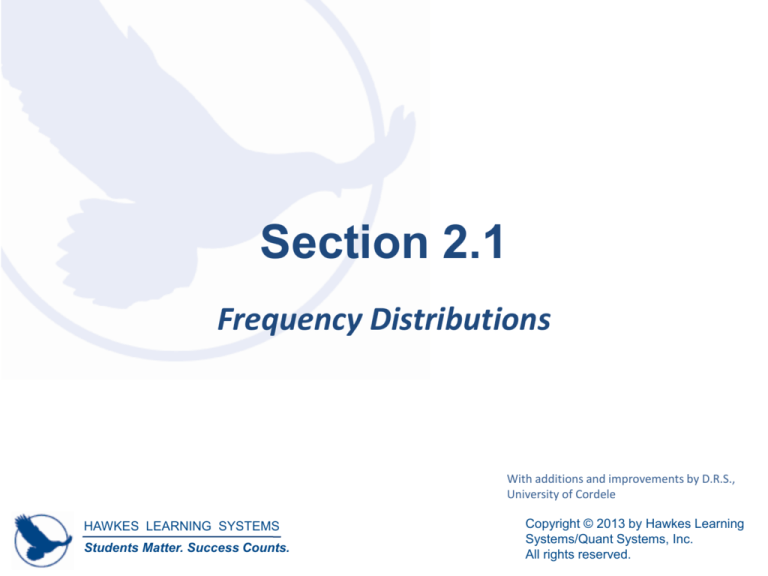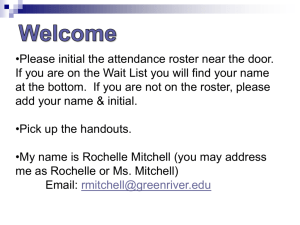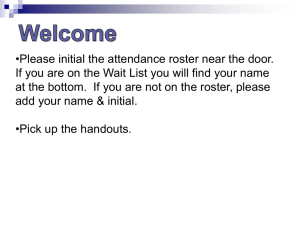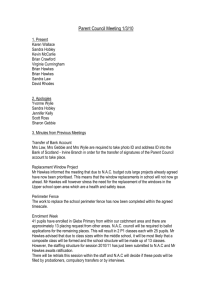
Section 2.1
Frequency Distributions
With additions and improvements by D.R.S.,
University of Cordele
HAWKES LEARNING SYSTEMS
Students Matter. Success Counts.
Copyright © 2013 by Hawkes Learning
Systems/Quant Systems, Inc.
All rights reserved.
Frequency Distributions
A distribution is a way to describe the structure of a
particular data set or population.
A frequency distribution is a display of the values that
occur in a data set and how often each value, or range
of values, occurs.
Frequencies (f) are the numbers of data values in the
categories of a frequency distribution.
A class is a category of data in a frequency distribution.
HAWKES LEARNING SYSTEMS
Students Matter. Success Counts.
Copyright © 2013 by Hawkes Learning
Systems/Quant Systems, Inc.
All rights reserved.
Are the data measurements
Qualitative or Quantitative?
–
–
–
–
–
Blood type
circle:
Dollars spent on meal
Heart rate, beats/min.
Model of car
Favorite fast food
restaurant
– Fuel efficiency, mi/gal
– My pain,
on a scale from 1 to 10
qualitative or quantitative
qualitative or quantitative
qualitative or quantitative
qualitative or quantitative
qualitative or quantitative
qualitative or quantitative
qualitative or quantitative
3
Frequency Distribution
for Categorical Data
Category
Frequency
Relative Frequency
(list the
(put the
(this category is what
categories
counts of how percent of the total
here in this many in this
sample size?)
column)
column)
(What order? Highest frequency down to lowest?
Lowest to highest? Alphabetical? It’s your design
decision.)
4
Categorical Frequency Distributions
are the fuel for the “Family Feud”
What question did they ask to obtain these answers?
(Photograph
borrowed from
some web site
somewhere;
I failed to record
the exact
source.)
5
Categorical (or, Qualitative)
Frequency Distribution example
“What state did you visit most recently?”
State visited (the category)
How many (the frequency)
Alabama
71
California
18
Florida
138
New York
7
South Carolina
48
Tennessee
27
Texas
53
Other states
70
TOTAL
432
6
Things we do with Categorical Frequency
Distributions
Sometimes we just leave them as tables of words and
numbers for reference and interpretation.
We draw pictures of them (future lessons).
– Bar graphs
– Pie charts
– Cutesy repeated icons variation of the bar graph
7
A famous categorical frequency distribution we
will revisit later
Draw this 5-card poker hand
Frequency
Royal Flush
4
Straight Flush (not including Royal Flush)
36
Four of a Kind
624
Full House
3,744
Flush (not including Royal Flush or Straight Flush)
5,108
Straight (not including Royal Flush or Straight Flush)
10,200
Three of a Kind
54,912
Two Pair
123,552
One Pair
1,098,240
Something that’s not special at all
1,302,540
Total
2,598,600
Quantitative Frequency Distribution
When the data are number measurements
Classes
Each class is a low-tohigh range of values
These are called the
“Class Limits”
Frequency
The frequency column
gives a count of how
many data values fit in
the class
9
Quantitative Frequency Distribution
(data are number measurements)
Placement Test
Score
0-9
Each class is a
“bucket”
10-19
containing all
20-29
the values in its
low-to-high
30-39
limits.
40-49
50 and above
the 0
to 9
bucket
the 10
to 19
bucket
etc.
How many
applicants
19
38
52
71
50
28
etc.
etc.
the 20
to 29
bucket
10
Quantitative Frequency Distribution
(data are number measurements)
Taxable
Income
How many
taxpayers
% of
taxpayers
GPA
Where are you
going to get the
raw data from?
How many
students
% of
students
How do you know
how many rows to
put in a frequency
distribution?
11
Quantitative Frequency Distribution
(data are number measurements)
mph
How do you pick the
low-to-high limits for each of
the classes?
Weight of
newborn
How many
newborns
% of
newborns
How many
cars
% of cars
Will the
distribution need
to be shown in a
graphic form, too,
as well as in this
tabular form?
12
Frequency Distributions
Constructing a Frequency Distribution
1. Decide how many classes should be in the
distribution. There are typically between 5 and 20
classes in a frequency distribution. Several different
methods can be used to determine the number of
classes that will show the data most clearly, but in
this textbook, the number of classes for a given data
set will be suggested.
HAWKES LEARNING SYSTEMS
Students Matter. Success Counts.
Copyright © 2013 by Hawkes Learning
Systems/Quant Systems, Inc.
All rights reserved.
Frequency Distributions
Constructing a Frequency Distribution (cont.)
2. Choose an appropriate class width. In some cases,
the data set easily lends itself to natural divisions,
such as decades or years. At other times, we must
choose divisions for ourselves. When starting a
frequency distribution from scratch, one method of
finding an appropriate class width is to begin by
subtracting the lowest number in the data set from
the highest number in the data set and dividing the
difference by the number of classes.
HAWKES LEARNING SYSTEMS
Students Matter. Success Counts.
Copyright © 2013 by Hawkes Learning
Systems/Quant Systems, Inc.
All rights reserved.
Frequency Distributions
Constructing a Frequency Distribution (cont.)
Rounding this number up gives a good starting point
from which to choose the class width. You will want to
choose a width so that the classes formed present a
clear representation of the data and include all
members of the data set, so make a sensible choice.
HAWKES LEARNING SYSTEMS
Students Matter. Success Counts.
Copyright © 2013 by Hawkes Learning
Systems/Quant Systems, Inc.
All rights reserved.
Frequency Distributions
Constructing a Frequency Distribution (cont.)
3. Find the class limits. The lower class limit is the smallest
number that can belong to a particular class, and the
upper class limit is the largest number that can belong
to a class. Using the minimum data value, or a smaller
number, as the lower limit of the first class is a good
place to begin. However, judgment is required. You
should choose the first lower limit so that reasonable
classes will be produced, and it should have the same
number of decimal places as the largest number of
decimal places in the data.
HAWKES LEARNING SYSTEMS
Students Matter. Success Counts.
Copyright © 2013 by Hawkes Learning
Systems/Quant Systems, Inc.
All rights reserved.
Frequency Distributions
Constructing a Frequency Distribution (cont.)
After choosing the lower limit of the first class, add the
class width to it to find the lower limit of the second
class. Continue this pattern until you have the desired
number of lower class limits. The upper limit of each
class is determined such that the classes do not
overlap. If, after creating your classes, there are any
data values that fall outside the class limits, you must
adjust either the class width or the choice for the first
lower class limit.
HAWKES LEARNING SYSTEMS
Students Matter. Success Counts.
Copyright © 2013 by Hawkes Learning
Systems/Quant Systems, Inc.
All rights reserved.
Frequency Distributions
Constructing a Frequency Distribution (cont.)
4. Determine the frequency of each class. Make a tally
mark for each data value in the appropriate class.
Count the marks to find the total frequency for each
class.
HAWKES LEARNING SYSTEMS
Students Matter. Success Counts.
Copyright © 2013 by Hawkes Learning
Systems/Quant Systems, Inc.
All rights reserved.
Frequency Distributions
Class width
The class width is the difference between the lower
limits or upper limits of two consecutive classes of a
frequency distribution.
The lower class limit is the smallest number that can
belong to a particular class.
The upper class limit is the largest number that can
belong to a particular class.
HAWKES LEARNING SYSTEMS
Students Matter. Success Counts.
Copyright © 2013 by Hawkes Learning
Systems/Quant Systems, Inc.
All rights reserved.
Example 2.1: Constructing a Frequency
Distribution
Create a frequency distribution using five classes for
the list of 3-D TV prices given in Table 2.2.
Table 2.2: 3-D TV Prices (in Dollars and in an Ordered Array)
1595
1599
1685
1699
1699
1699
1699
1757
1787
1799
1799
1885
1888
1899
1899
1899
1984
1999
1999
1999
HAWKES LEARNING SYSTEMS
Students Matter. Success Counts.
Copyright © 2013 by Hawkes Learning
Systems/Quant Systems, Inc.
All rights reserved.
Example 2.1: Constructing a Frequency
Distribution (cont.)
Solution
Because we were told how many classes to include,
_____ classes, we will begin by deciding on a class
width. Subtract the lowest data value from the highest
and divide by the number of classes:
ℎ𝑖𝑔ℎ − 𝑙𝑜𝑤
= 𝑐𝑙𝑎𝑠𝑠 𝑤𝑖𝑑𝑡ℎ
ℎ𝑜𝑤 𝑚𝑎𝑛𝑦 𝑐𝑙𝑎𝑠𝑠𝑒𝑠
This gives us a class width of $ __________.
HAWKES LEARNING SYSTEMS
Students Matter. Success Counts.
Copyright © 2013 by Hawkes Learning
Systems/Quant Systems, Inc.
All rights reserved.
Example 2.1: Constructing a Frequency
Distribution (cont.)
We will stop here and consider some options. Choosing
a class width of $81 does seem perfectly reasonable
from a theoretical point of view. However, one should
consider the impression created by having TV prices
grouped in intervals of $81. Can you imagine presenting
this data to a client?
1500 – 1580, 1581 – ______, ______ – _____, etc.
Instead, it would be more reasonable to group TV
prices by intervals of $100. Therefore, we will choose
our class width to be $100.
HAWKES LEARNING SYSTEMS
Students Matter. Success Counts.
Copyright © 2013 by Hawkes Learning
Systems/Quant Systems, Inc.
All rights reserved.
Example 2.1: Constructing a Frequency
Distribution (cont.)
Next, we need to choose a starting point for the
classes, that is, the first lower class limit. One should
always first consider using the smallest data value for
the beginning point. In this case, if we choose the
smallest TV price, we would be starting the first class at
$_____ with a width of $100. However, given that
we’ve chosen a class width of $100, it is more natural
to begin the first class at $_____.
HAWKES LEARNING SYSTEMS
Students Matter. Success Counts.
Copyright © 2013 by Hawkes Learning
Systems/Quant Systems, Inc.
All rights reserved.
Example 2.1: Constructing a Frequency
Distribution (cont.)
Now let’s continue building the class limits. Adding the
class width of $100 to $1500, we obtain a second lower
class limit of $______. The next lower limit is found by
adding $____ to $_____. We continue in this fashion
until we have five lower class limits, one for each of our
five classes.
Finally, we need to determine appropriate upper class
limits. Again, be reasonable. Remember, too, that the
classes are not allowed to overlap.
HAWKES LEARNING SYSTEMS
Students Matter. Success Counts.
Copyright © 2013 by Hawkes Learning
Systems/Quant Systems, Inc.
All rights reserved.
Example 2.1: Constructing a Frequency
Distribution (cont.)
Because the data are in whole dollar amounts, it makes sense to
choose upper class limits that are one dollar less than the next
lower limit. The classes we have come up with are as follows.
3-D TV Prices
Class
Frequency
$1500 - $______
$______ - $______
$______ - $______
$______ - $______
$______ - $______
HAWKES LEARNING SYSTEMS
Students Matter. Success Counts.
Copyright © 2013 by Hawkes Learning
Systems/Quant Systems, Inc.
All rights reserved.
Example 2.1: Constructing a Frequency
Distribution (cont.)
Note that the last upper class limit is also the maximum
value in the data set. COINCIDENCE!
This will not necessarily occur in every frequency table.
However, we have included all the data values in our
range of classes, so no adjustments to the classes are
necessary. (Important for every data value to find a
home in one of the classes, nobody’s left out.)
Tabulating the number of data values that occur in each
class produces the following frequency table.
HAWKES LEARNING SYSTEMS
Students Matter. Success Counts.
Copyright © 2013 by Hawkes Learning
Systems/Quant Systems, Inc.
All rights reserved.
Example 2.1: Constructing a Frequency
Distribution (cont.)
3-D TV Prices
Class
Frequency
$1500 - $1599
____
$1600 - $1699
____
$1700 - $1799
____
$1800 - $1899
____
$1900 - $1999
____
Note that the sum of the frequency column is ______
and the number of data values in the original list
is _____. They are { equal, unequal }. What does
that mean? _________________________________
HAWKES LEARNING SYSTEMS
Students Matter. Success Counts.
Copyright © 2013 by Hawkes Learning
Systems/Quant Systems, Inc.
All rights reserved.
Characteristics of a Frequency Distribution
Class boundary
A class boundary is the value that lies halfway between
the upper limit of one class and the lower limit of the
next class. After finding one class boundary, add (or
subtract) the class width to find the next class
boundary. The boundaries of a class are typically given
in interval form: lower boundary–upper boundary.
HAWKES LEARNING SYSTEMS
Students Matter. Success Counts.
Copyright © 2013 by Hawkes Learning
Systems/Quant Systems, Inc.
All rights reserved.
Example 2.2: Calculating Class Boundaries
Calculate the class boundaries for each class in the
frequency distribution from Example 2.1.
Solution
Look at the first and second classes. The upper limit of
class one is 1599. The lower limit of class two is 1600.
Thus, the class boundary between the first two classes
is calculated as follows.
𝟏𝟓𝟗𝟗 + 𝟏𝟔𝟎𝟎
→ $__________
𝟐
HAWKES LEARNING SYSTEMS
Students Matter. Success Counts.
Copyright © 2013 by Hawkes Learning
Systems/Quant Systems, Inc.
All rights reserved.
Example 2.2: Calculating Class Boundaries
(cont.)
Recall that the class width is 100. Adding 100 to 1599.5 gives the
next class boundary. You can repeat this step to find the
remaining class boundaries.
3-D TV Prices with Class Boundaries
Class
Frequency
Class Boundaries
$1500 - $1599
$1600 - $1699
$1700 - $1799
$1800 - $1899
$1900 - $1999
2
5
4
5
4
_______ - _______
1599.5 -_______
_______ - _______
_______ - _______
_______ - _______
HAWKES LEARNING SYSTEMS
Students Matter. Success Counts.
Copyright © 2013 by Hawkes Learning
Systems/Quant Systems, Inc.
All rights reserved.
Characteristics of a Frequency Distribution
Class Midpoint
Lower Limit Upper Limit
Class Midpoint =
2
HAWKES LEARNING SYSTEMS
Students Matter. Success Counts.
Copyright © 2013 by Hawkes Learning
Systems/Quant Systems, Inc.
All rights reserved.
Example 2.3: Calculating Class Midpoints
Calculate the midpoint of each class in the frequency
distribution from Example 2.1.
Solution
The midpoint is the sum of the class limits divided by
two. For the first class, the midpoint is calculated as
follows.
−
→ $ ________________
HAWKES LEARNING SYSTEMS
Students Matter. Success Counts.
Copyright © 2013 by Hawkes Learning
Systems/Quant Systems, Inc.
All rights reserved.
Example 2.3: Calculating Class Midpoints (cont.)
We can use this same calculation to find the midpoints of the
remaining classes. Another method is to add 100 (the class
width) to the first midpoint, as we did with class boundaries.
3-D TV Prices with Class Boundaries Midpoints
Class
Frequency
Class Boundaries
Midpoints
$1500 - $1599
$1600 - $1699
$1700 - $1799
$1800 - $1899
$1900 - $1999
2
5
4
5
4
1549.5
__________
__________
__________
__________
HAWKES LEARNING SYSTEMS
Students Matter. Success Counts.
Copyright © 2013 by Hawkes Learning
Systems/Quant Systems, Inc.
All rights reserved.
Characteristics of a Frequency Distribution
Relative Frequency
The relative frequency is the fraction or percentage of
the data set that falls into a particular class, given by
f
Relative Frequency
n
where f is the class frequency,
n is the sample size, given by n fi , and
fi is the frequency of the i th class.
HAWKES LEARNING SYSTEMS
Students Matter. Success Counts.
Copyright © 2013 by Hawkes Learning
Systems/Quant Systems, Inc.
All rights reserved.
Example 2.4: Calculating Relative Frequencies
(cont.)
3-D TV Prices with Relative Frequencies
Class
Frequency
$1500 - $1599
2
$1600 - $1699
5
$1700 - $1799
4
$1800 - $1899
5
$1900 - $1999
4
HAWKES LEARNING SYSTEMS
Students Matter. Success Counts.
Relative
Frequency
The Relative Frequency
for a class is:
class frequency
total of frequency col.
Optionally convert it to
a percent.
Compute these relative
frequencies as percents.
Copyright © 2013 by Hawkes Learning
Systems/Quant Systems, Inc.
All rights reserved.
Calculate relative frequency as decimal
Draw this 5-card poker hand
Frequency
Royal Flush
4
Straight Flush (not including Royal Flush)
36
Four of a Kind
624
Full House
3,744
Flush (not including Royal Flush or Straight
Flush)
5,108
Straight (not including Royal Flush or Straight
Flush)
10,200
Three of a Kind
54,912
Two Pair
123,552
One Pair
1,098,240
Something that’s not special at all
1,302,540
Total
2,598,600
Relative Frequ’cy
Characteristics of a Frequency Distribution
Cumulative Frequency
The cumulative frequency is the sum of the
frequencies of a given class and all previous classes.
The cumulative frequency of the last class equals the
sample size.
HAWKES LEARNING SYSTEMS
Students Matter. Success Counts.
Copyright © 2013 by Hawkes Learning
Systems/Quant Systems, Inc.
All rights reserved.
Example 2.5: Calculating Cumulative
Frequencies
Calculate the cumulative frequency for each class in the
frequency distribution from Example 2.1.
Solution
3-D TV Prices with Cumulative Frequencies
Class
Frequency
$1500 - $1599
$1600 - $1699
$1700 - $1799
$1800 - $1899
$1900 - $1999
2
5
4
5
4
HAWKES LEARNING SYSTEMS
Students Matter. Success Counts.
Cumulative Frequency
2
_______
_______
_______
_______
Copyright © 2013 by Hawkes Learning
Systems/Quant Systems, Inc.
All rights reserved.
Example 2.6: Characteristics of a Frequency
Distribution
Data collected on the numbers of miles that Beta Corp.
employees drive to work daily are listed below. Use
these data to create a frequency distribution that
includes the class boundaries, midpoint, relative
frequency, and cumulative frequency of each class. Use
six classes. Be sure that your class limits have the same
number of decimal places as the largest number of
decimal places in the data.
HAWKES LEARNING SYSTEMS
Students Matter. Success Counts.
Copyright © 2013 by Hawkes Learning
Systems/Quant Systems, Inc.
All rights reserved.
Example 2.6: Characteristics of a Frequency
Distribution (cont.)
Class width:
max value – min value
6 classes
Numbers of Miles Beta Corp. Employees
Drive to Work Each Day
3.8
10.2
11.9
2.7
1
5.5
9.3
3.7
4.8
6.5
9.1
7.3
5.8
6.2
9.1
7
11
1.4
Instead of using the rough decimal value, let’s make
the class width be a nicer value; let’s make it ________.
HAWKES LEARNING SYSTEMS
Students Matter. Success Counts.
Copyright © 2013 by Hawkes Learning
Systems/Quant Systems, Inc.
All rights reserved.
Example 2.6: Characteristics of a Frequency
Distribution (cont.)
Numbers of Miles Beta Corp. Employees
Drive to Work Each Day
Choose a
nice starting
Class
Frequency
point for the
______ - ______
______ - ______
lower class
______ - ______
limit of the
______ - ______
first class.
______ - ______
Fill in all the
______ - ______
class limits.
Check: Will every data value fit in one of the classes?
If so, go ahead; count to find the frequency of each class.
HAWKES LEARNING SYSTEMS
Students Matter. Success Counts.
Copyright © 2013 by Hawkes Learning
Systems/Quant Systems, Inc.
All rights reserved.
Example 2.6: Characteristics of a Frequency
Distribution (cont.)
Numbers of Miles Beta Corp. Employees Drive to Work Each Day
Class
Frequency
1.0–2.9
3
3.0–4.9
3
5.0–6.9
4
7.0–8.9
2
9.0–10.9
4
Class
Boundaries
HAWKES LEARNING SYSTEMS
Students Matter. Success Counts.
Mid
point
Relative Frequency
Cumulative
Frequency
Copyright © 2013 by Hawkes Learning
Systems/Quant Systems, Inc.
All rights reserved.




